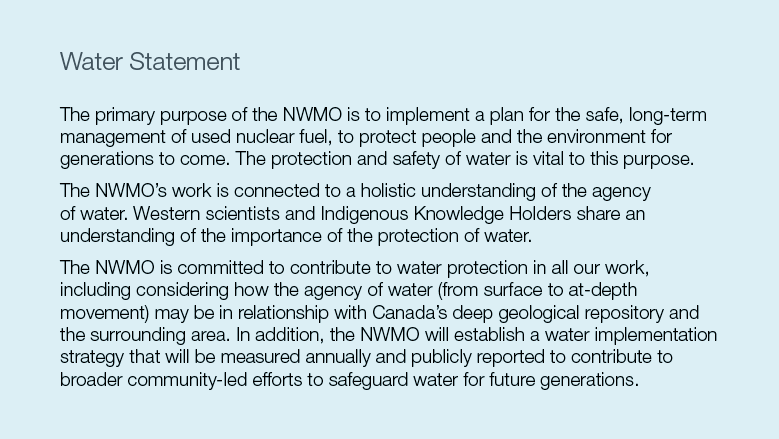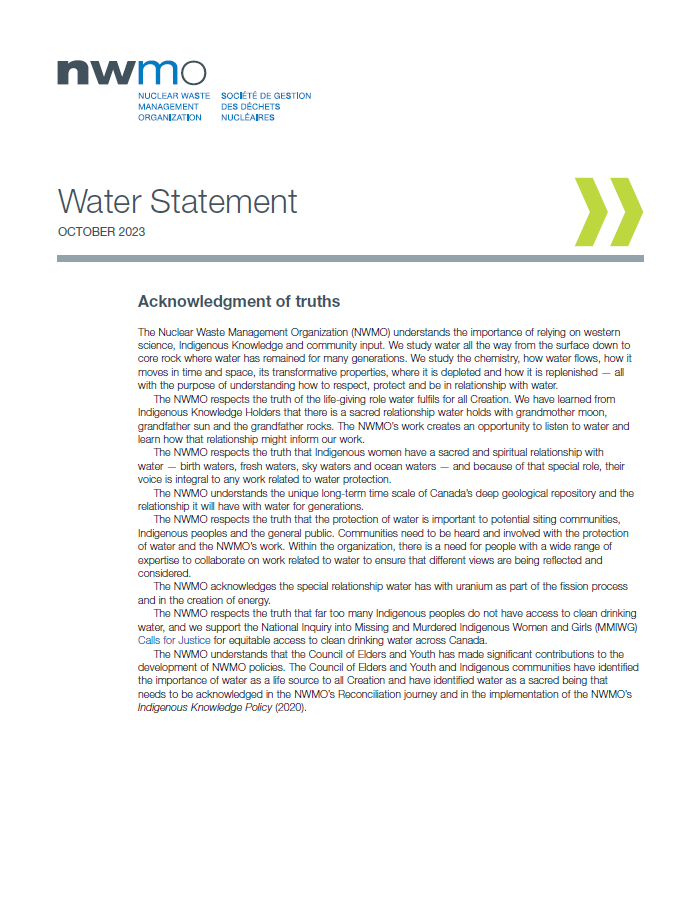Protecting water together
See how
Our commitment to water protection
The NWMO understands the importance of water and the need to protect it for generations to come. It is at the core of what we do and a shared commitment with Canadians and Indigenous peoples. As part of that shared commitment, we invest in and support a range of projects to advance our understanding of water, contribute to the conservation of aquatic species and local habitats, provide financial support to people to improve their water wells, and participate in water conservation and shoreline preservation efforts.
Following our shared commitment with Canadians and Indigenous peoples, the NWMO will only proceed with the development of a deep geological repository with the consent of Wabigoon Lake Ojibway Nation and the Township of Ignace, or Saugeen Ojibway Nation and the Municipality of South Bruce.
Our Water Statement
Since our establishment in 2002, collaboration with communities has been at the core of the NWMO’s planning. Through discussions with Canadians and Indigenous peoples, the NWMO identified a common theme of questions about how the project will protect water. As one way to reinforce the importance of this work, we decided to publish a Water Statement, which outlines how the entire purpose of the plan for used nuclear fuel is to protect people and the environment, including water.
Documents
Two knowledge systems
By drawing from two knowledge systems—western science and Indigenous Knowledge—we are constantly learning about how water sustains us, the significant cultural importance of water to Indigenous peoples and the personal connections we all have with water.
Western science
The two potential sites being considered for a deep geological repository are both further away from large bodies of water than many current storage locations for used nuclear fuel in Canada.
At the depth of the proposed deep geological repository, there is very little water. The repository will contain and isolate used nuclear fuel from water and the surrounding environment using multiple barriers.
One barrier is the rock itself. The rock at the repository depth—about as deep or deeper than the CN Tower is tall—is isolated from watersheds. The deep groundwater at that depth has essentially been disconnected from the water we see and use for millions or even billions of years.
Bentonite clay is another barrier. Bentonite is proven to be a powerful barrier to water flow. It swells when exposed to water, making it an excellent sealing material. Bentonite is also very stable, as seen in natural formations formed millions to hundreds of millions of years ago.
We also plan to use a thin copper coating on the used nuclear fuel containers, which are made of steel and have the mechanical strength to withstand pressures of more than 500 metres of overlying rock and three-kilometre-thick glaciers during a future ice age. Copper is a natural material that is known to be durable under deep rock conditions and resistant to corrosion. The NWMO has published findings that show that the copper coating on our used fuel containers is robust and thick enough to withstand any corrosive effects for over 1,000,000 years. Naturally pure copper ore has been mined from around the Great Lakes region. Indigenous communities have explored the copper deposits in the same area for thousands of years, building substantial local traditional knowledge.
Indigenous Knowledge
Indigenous peoples see water as Mother Earth’s lifeline, so it is important that our work protects Mother Earth and water. In Indigenous peoples’ worldview, everything Mother Earth created has spirit and is viewed as alive, including water. The NWMO understands and respects this important belief, and we are committed to protecting water and the communities that surround it.
We are working with communities, including Indigenous Knowledge Holders, to ensure our work is guided by the responsibility to protect people and the environment, including water, for future generations.
Understanding water and its role in Canada's plan
Watch now
Meet Jessica Perritt, NWMO water steward and Section Manager, Indigenous Knowledge and Reconciliation
Watch Now
Meet Dr. Bob Hanner, NWMO water steward and Professor of Integrative Biology at the University of Guelph
Watch now
Meet Joanne Jacyk, water steward and Director, Site Selection Ignace/Northwest
Watch now


